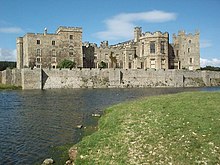Henry Vane, 1st Earl of Darlington
Henry Vane, 1st Earl of Darlington | |
|---|---|
 Arms of Vane: Azure, three sinister gauntlets (appaumée) or[1] These are a difference of the arms of the Fane family, Earls of Westmorland from 1624, which show: three dexter gauntlets back affrontée, with identical tinctures | |
| Member of the Great Britain Parliament for Launceston | |
| In office 1726–1727 Serving with John Freind | |
| Preceded by |
|
| Succeeded by | |
| Member of the Great Britain Parliament for St Mawes | |
| In office 1727–1741 Serving with
| |
| Preceded by | |
| Succeeded by | |
| Member of the Great Britain Parliament for Ripon | |
| In office 1741–1747 Serving with William Aislabie | |
| Preceded by |
|
| Succeeded by |
|
| Member of the Great Britain Parliament for County Durham | |
| In office 1747–1753 Serving with George Bowes | |
| Preceded by |
|
| Succeeded by |
|
| Personal details | |
| Born | c. 1705 |
| Died | 6 March 1758 |
| Political party | Whig |
| Spouse | Lady Grace Fitzroy |
| Children | |
Henry Vane, 1st Earl of Darlington, PC (c. 1705 – 6 March 1758), known as Lord Barnard between 1753 and 1754, was a British politician who sat in the House of Commons from 1726 to 1753 when he succeeded to a peerage as Baron Barnard.
Life[edit]
Vane was the eldest son of Gilbert Vane, 2nd Baron Barnard of Raby Castle, Staindrop, county Durham, and his wife, Mary Randyll, daughter of Morgan Randyll of Chilworth, Surrey.[2] His sister Anne Vane was a mistress to Frederick, Prince of Wales.[3] He was educated privately. He married Lady Grace Fitzroy, daughter of Charles FitzRoy, 2nd Duke of Cleveland on 2 September 1725.[2]
Career[edit]

Vane contested County Durham as a Whig on his family's interest at the 1722 British general election, but was unsuccessful. He was brought in by the ministry as Member of Parliament for Launceston at a by-election on 31 May 1726. At the 1727 British general election he planned to stand for county Durham, but stood down to avoid splitting the Whig vote, and the ministry found him another seat at St Mawes where he was returned as MP unopposed. He went into opposition, and attached himself to his wife's first cousin William Pulteney. He never spoke in the House, which was said to be because of 'a monstrous tongue which lolled out of his mouth'. He was returned again in a contest for St Mawes at the 1734 British general election, on the Boscawen interest, and, at the 1741 British general election, was returned unopposed as MP for Ripon on the Aislabie interest.
After Walpole's fall in 1742, Pulteney procured for Vane a lucrative sinecure as Vice-Treasurer and Paymaster General of Ireland and he also became a Privy Counsellor (Ireland) in 1742. Vane lost his Irish post when Pulteney and his adherents were turned out in December 1744. He was finally returned for county Durham at the 1747 British general election as a government supporter. He became a follower of his kinsman, the Duke of Newcastle, cultivating him so assiduously that in 1749 he was appointed a Lord of the Treasury which he retained to 1755. On 27 April 1753 he succeeded to the peerage as 3rd Baron Barnard on the death of his father and became Lord Lieutenant of Durham from 1753 to 1758. He was rewarded by Newcastle with an earldom, as 1st Earl of Darlington and 1st Viscount Barnard on 3 April 1754 and held the post of Joint Paymaster of the Forces between 1755 and 1756.[2]
Death and legacy[edit]
Vane died on 6 March 1758. He was succeeded in his titles by his son Henry.[2] With his wife Grace, he had seven children
- Lady Mary Vane[4]
- Henry Vane, 2nd Earl of Darlington, (1726 – 8 Sep 1792)[4]
- Lady Anne Vane, a botanist (25 June 1726 – 18 February 1776)[4][5]
- Hon. Frederick Vane, b. 26 June 1732[4]
- Hon. Charles Vane
- Hon. Raby Vane (2 January 1736 – 23 October 1769)[4]
- Lady Harriet Vane (27 January 1739 – January 1759)[4][6]
References[edit]
- ^ Debrett's Peerage, 1968, p.115, which omits appaumée, useful in differentiating from Fane arms; concerning appaumée Cussans (1898) states: "In blazoning a Hand, besides stating what position it occupies, and whether it be the dexter or sinister, and erased or couped, it must be mentioned whether it be clenched or appaumé". (Cussans, John, Handbook of Heraldry, 2nd Edition, London, 1868, p.47 [1], p.92)
- ^ a b c d "VANE, Hon. Henry (c.1705-58), of Raby Castle, co. Dur". History of Parliament Online. Retrieved 28 April 2019.
- ^ Matthew Kilburn, 'Vane, Anne (d. 1736)’, Oxford Dictionary of National Biography, Oxford University Press, 2004; online edn, May 2008 accessed 19 Feb 2017
- ^ a b c d e f "Henry Vane, 1st Earl of Darlington". /ThePeerage.com. Retrieved 18 March 2015.
- ^ "Lady Anne Monson (Biographical details)". British Museum. Retrieved 19 February 2017.
- ^ The Register Book of Burials in the Parish of St James in Westminster in the County of Middlesex. Volume IV. 1754-1812. 23 January 1759.
External links[edit]
- 1700s births
- 1758 deaths
- Earls in the Peerage of Great Britain
- Lord-Lieutenants of Durham
- Members of the Parliament of Great Britain for English constituencies
- Members of the Privy Council of Ireland
- Paymasters of the Forces
- Members of the Parliament of Great Britain for constituencies in Cornwall
- Whig (British political party) MPs
- British MPs 1722–1727
- British MPs 1727–1734
- British MPs 1734–1741
- British MPs 1747–1754
- Vane family
- Barons Barnard
- People from Staindrop
